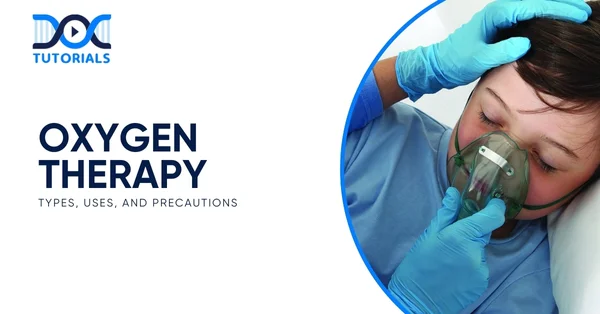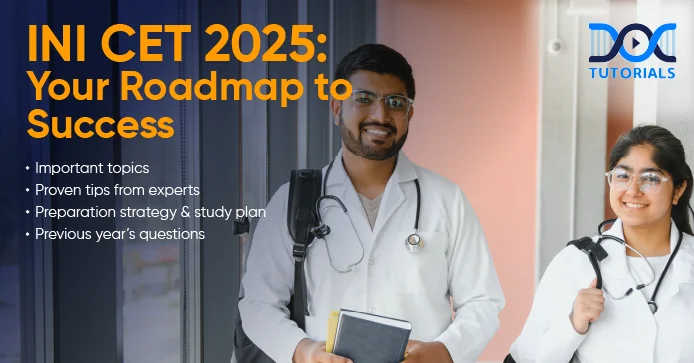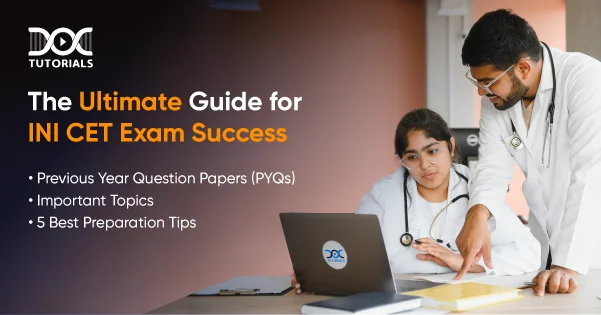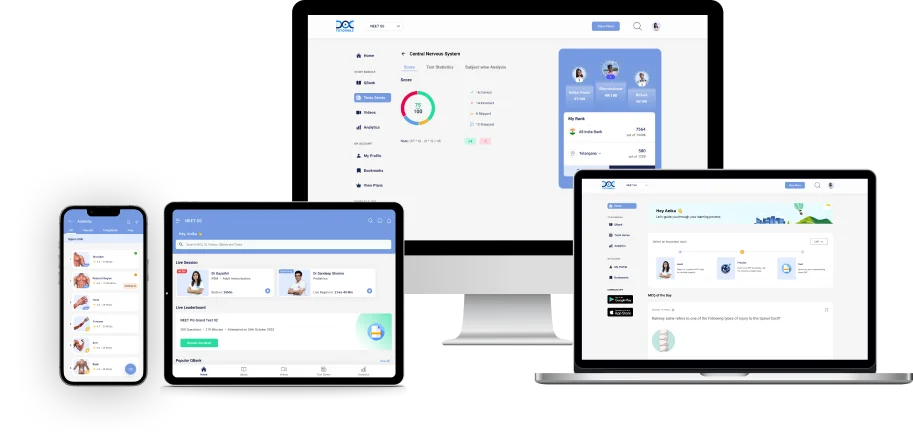Oxygen Therapy: Types, Uses, and Precautions

Oxygen therapy is a medical treatment that gives extra oxygen to those who have low blood oxygen levels (hypoxaemia). It is an important part of treating a number of heart and lung problems, including COPD (Chronic Obstructive Pulmonary Disease), pneumonia, heart failure, and COVID-19.
Oxygen therapy has been used in clinical practice since 1917 and is still one of the most prevalent treatments in hospitals in the industrialised world since it has been shown to be effective. If you wish to take the NEET PG exam as a medical student, you need to know how this therapy works.
Here is a guide to help you out!
What is Oxygen Therapy?
Oxygen administration refers to the medical delivery of supplemental oxygen to patients who are unable to breathe properly and sustain proper blood oxygenation on their own due to respiratory or systemic illnesses.
Oxygen therapy sustains vital organ function, avoids hypoxemia, and enhances symptoms such as fatigue, shortness of breath, and insomnia. Oxygen therapy is either temporary or chronic, depending on the etiological disease. It is usually applied in conditions like COPD, sleep apnoea, emphysema, and COVID-19.
What are the Types of Oxygen Therapy?
Oxygen therapy is administered through several different systems, based upon the patient’s needs, mobility, and severity of disease. The following are the main types:
- Compressed Gas System (Oxygen Cylinders)
They are high-pressure metal cylinders that contain 100% oxygen in liquid form. A regulator and flow meter regulate oxygen delivery, usually with an oxygen-conserving device to deliver oxygen only upon inhalation. Portable systems need frequent refilling and should be checked by a pressure gauge.
Pure oxygen is also kept in an insulated, thermos-type container in an extremely cold liquid-form. When released, it expands into a gas for breathing. These devices store more oxygen in small tanks and are ideal for active patients. Liquid oxygen, however, evaporates with the passage of time and has to be consumed immediately.
- Oxygen Concentrators
These are battery or electric units that pull room air in, remove nitrogen, and release concentrated oxygen (typically ~90–95%). They provide constant oxygen delivery and do away with refilling. While less mobile than tanks, smaller FAA-approved (Federal Aviation Administration) ones exist for travel and home use.
- Hyperbaric Oxygen Therapy (HBOT)
In contrast to other systems, HBOT involves the inhalation of 100% oxygen in a pressurised chamber (2–3 times atmospheric pressure). It increases oxygen delivery to tissues and is also applied in conditions such as carbon monoxide poisoning, decompression sickness, or non-healing wounds. Monitoring is needed to avoid oxygen toxicity.
- Oxygen Mask
It is classified into 3 types. These comprise:
- Simple Face Mask
This mask provides oxygen at 6–10 L/min, with an FiO₂ of 35–55%. It is utilised in individuals who are not tolerant of a nasal cannula but require moderate oxygenation. It encloses both the mouth and nose, providing more oxygen than low-flow systems.
- Partial Rebreather Mask
With a reservoir bag included, this mask permits some oxygen-rich air exhaled to be reused. At 6–10 L/min flow rates, it provides FiO₂ concentrations between 50–75%. It is beneficial for patients requiring more oxygen concentration but not complete non-rebreather capability.
- Non-Rebreather Mask (NRB)
This high-concentration delivery mask is equipped with one-way valves to avoid mixing exhaled air with oxygen in the reservoir bag. It delivers 90–100% FiO₂ at a rate of 10–15 L/min. It is most suitable for emergency and critical care conditions that need maximum oxygenation without intubation.
- Venturi Mask (Precise FiO₂ Delivery)
Venturi mask is crucial in COPD patients with fixed and accurate delivery of FiO₂ through jet adapters. The venture mask flow rates are 4–12 L/min, where the colour-coded nozzles include blue = 24%, yellow = 28%, white = 31%, green = 35%, pink = 40%, orange = 50%. The venturi mask colour coding facilitates easy recognition of the selected oxygen concentration.
What are the Uses of Oxygen Therapy?
Oxygen therapy is utilised to correct hypoxemia and augment vital function in acute and chronic medical conditions, improving organ function, symptom management, and survival. Here are the common appliances of oxygen therapy:
- Correction of Hypoxemia: It normalises oxygen content in the blood and helps avert organ dysfunction.
- COPD: Survival in patients with COPD who have PaO₂ ≤ 55 mmHg or SaO₂ ≤ 88% is enhanced by long-term oxygen therapy.
- Pulmonary Hypertension: Treating the pulmonary artery pressure and the ability to oxygenate will relieve symptoms.
- Heart Failure: While it isn’t a cure, oxygen therapy can be a useful and stabilising method for heart failure, mainly by addressing the low oxygen levels that may arise when the heart fails to pump blood properly. It boosts the oxygen delivered to your body’s tissues, which helps lessen the strain on the heart.
- Obstructive Sleep Apnoea (OSA): In limited situations, this modality serves to correct hypoxemia during sleep and is associated with CPAP (continuous positive airway pressure) therapy.
- Acute Respiratory Conditions: Several acute respiratory conditions can also be helped by the changes meant from this therapy; pneumonia, acute asthma exacerbation, ARDS (acute respiratory distress syndrome), acute lung injury, etc.
- Post-Operative Support: May help post-anaesthesia and post-operative patients who need help obtaining adequate oxygenation.
- Emergency Resuscitation: High-flow oxygen is a vital component of CPR (cardiopulmonary resuscitation), major trauma, shock, seizures, or anaphylaxis. This approach involves the use of a high-flow oxygen mask.
- Transportation and Ambulance Use: High-flow oxygen may be used as pre-hospital emergency care in ambulances prior to being shifted to a hospital.
- Hypothermia: Oxygen may serve to protect tissues in low energised states (i.e. hypothermia).
- Increased Exercise Tolerance: Facilitates physically active patients with respiratory restrictions to exercise with decreased dyspnoea.
- Decreased Dyspnoea and Fatigue: Alleviates chronic and acute hypoxemic symptoms.
- Brain Function Improvement: Improves brain function, alertness, and concentration during hypoxemic conditions.
- Assistance in Other Therapies: Oxygen stabilises patients under infection treatment, chemotherapy, or other intensive therapy.
- Hyperbaric Oxygen Therapy: Applied in carbon monoxide poisoning, air embolism, and the healing of chronic wounds by providing high oxygen under pressure.
- Enhanced Quality of Life: Facilitates patients to carry out daily activities and sleep more comfortably by abolishing chronic breathlessness.
What are the Precautions to Remember During Oxygen Therapy?
Here are the common precautionary measures to keep in mind during oxygen therapy:
- Avoid smoking in proximity to an oxygen tank. Additionally, maintain a distance of at least 5 feet from any flames, including those from gas stoves, candles, fireplaces, and fire pits while using oxygen.
- Store oxygen tanks in areas with good ventilation. This will allow the small amounts of oxygen that the tanks continuously release to disperse into the air, preventing accumulation that could pose a fire risk.
- Make sure that oxygen tanks are secured in an upright position, either to a stand or a fixed object. Never roll an oxygen cylinder, as a tank that falls or rolls could crack, leading to pressure that may render the tank explosive.
- Keep a minimum distance of 8 feet from devices that produce heat, such as heaters and electrical appliances.
- Opt for cotton clothing and bedding instead of wool, nylon, and synthetic materials, which can generate static electricity sparks.
- Avoid using flammable materials, including aerosol sprays, cleaning agents, and petroleum products, near an oxygen tank.
- Always have a fire extinguisher readily available and ensure you know how to operate it. Also, verify that your smoke alarms are functioning properly.
FAQs About Oxygen Therapy
- What safety measures should doctors and caregivers follow when handling oxygen?
Aspiring doctors pursuing medical exams like NEET PG should know that oxygen encourages combustion and needs to be handled carefully. Other things to keep in mind are no smoking in the vicinity of the oxygen, keeping cylinders at least 5 feet from sources of heat, and checking for fire or electrical hazards in the area where oxygen will be used.
- What are the main ways oxygen can be delivered to patients?
Oxygen therapy can be delivered from concentrators, pressurised gas cylinders or liquid oxygen systems. Each method will be dependent upon how much oxygen is needed, as well as when it is needed.
- What does “oxygen flow rate” mean in treatment?
The flow rate refers to the amount of oxygen a patient will receive each minute. It will be written as the amount (in litres per minute) that is being administered. The flow rate is set based on the medical needs of the patient and based on how oxygen is delivered.
- How long might someone need to use oxygen therapy?
Oxygen may be used for a very short term (like for recovery from an illness) or it may be used long term for chronic medical conditions. In some cases, patients may be required to use oxygen all the time, even 24/7. However, these things depend on the medical assessment the doctor performs.
- What are the essential things to remember while using oxygen safely?
Aspiring doctors pursuing medical exams need to know that they should avoid aerosol sprays near oxygen, steer clear of oil-based products, and never handle the oxygen therapy equipment with greasy hands—to prevent fire risks.
For clinical decision-making and achieving NEET PG success, it is critical to have an understanding of oxygen administration—its indications, modes of delivery, and safety precautions. Such complicated concepts are simplified by DocTutorials.
The well-framed syllabus, topic-oriented instruction, and examination-oriented system of DocTutorials facilitate efficient preparation. If you want to excel in high-yield areas with speed and efficacy, DocTutorials is your trusted companion.
Join DocTutorials today and explore our NEET PG course to excel in your medical career.
Latest Blogs
-

NEET PG Exam 2025- Date, Pattern, Marking Scheme, Subject Wise Weightage, and Exam Mode
NEET PG Exam 2025 is the ultimate gateway for medical graduates aspiring to pursue postgraduate courses in medicine, including MD,…
-

INI CET Exam 2025: Your Roadmap to Success – Key Topics, Strategies, and Lessons from Last Year’s Papers
The INI CET exam is more than just a test; it’s a significant milestone for many medical students aiming to…
-

INI CET Exam Success: Previous Year Question Papers & Ultimate Guide – INI CET PYQ
One can feel overwhelmed while preparing for the INI CET (Institute of National Importance Combined Entrance Test). A vast syllabus,…




